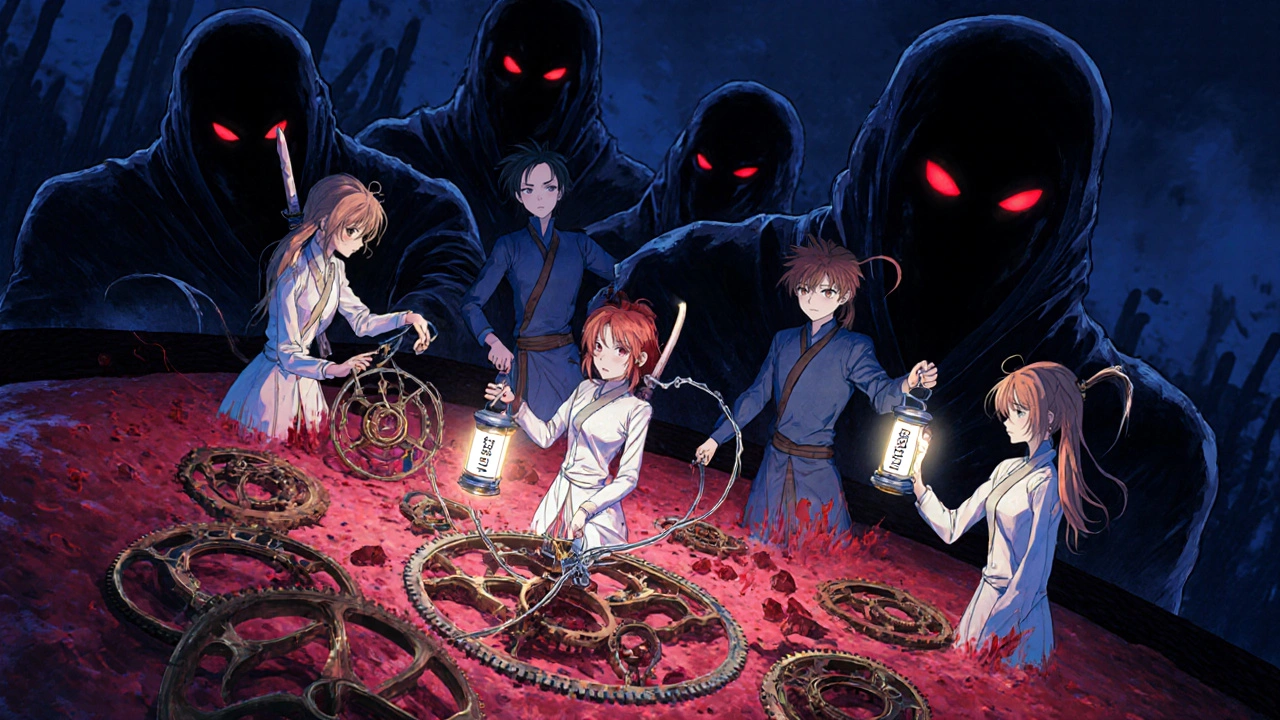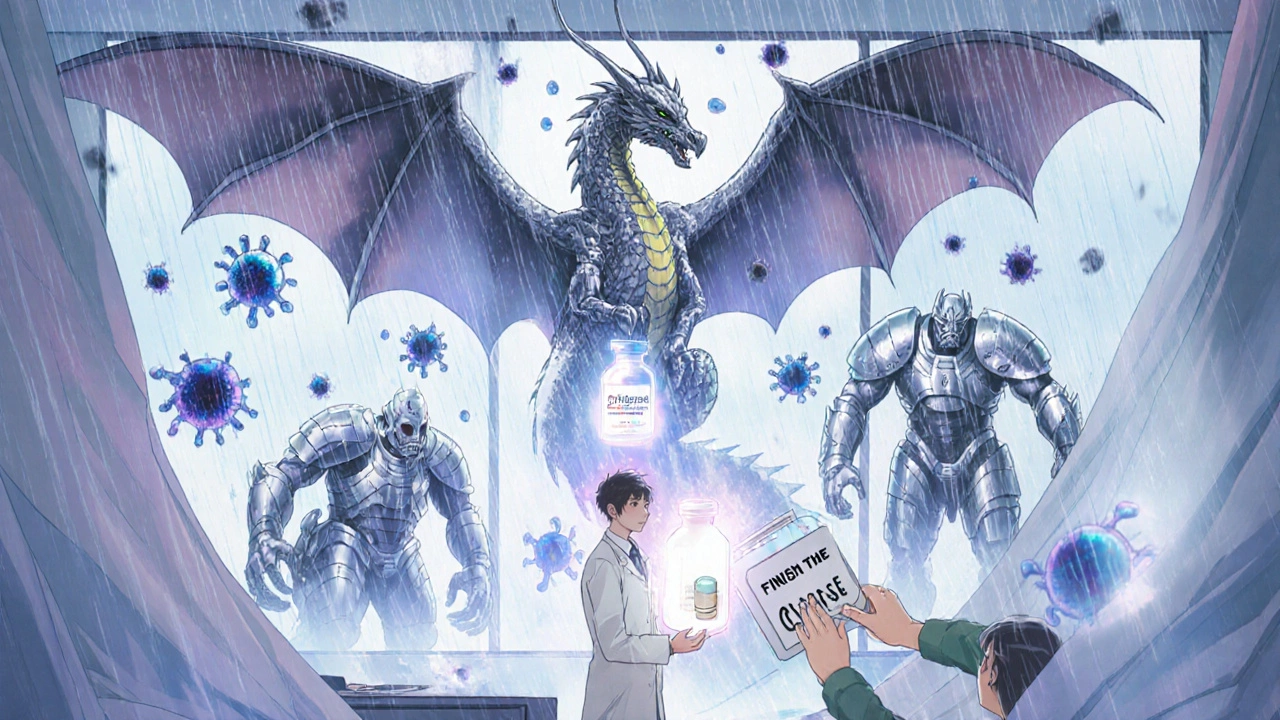Antibiotics are one of the most important medical breakthroughs of the last century. They don’t cure colds or the flu - those are viral. But when you have a bacterial infection like strep throat, a bad urinary tract infection, or a skin abscess, antibiotics can mean the difference between a few days of feeling awful and something much worse. Around 73 billion doses of antibiotics are used worldwide every year. That’s a lot. And yet, many people still don’t understand how they actually work.
What Antibiotics Actually Do
Antibiotics don’t just kill bacteria. Some stop them from multiplying. That’s called bacteriostatic. Others punch holes in the bacterial cell wall until it bursts - that’s bactericidal. Either way, your immune system finishes the job. The key is that antibiotics target things only bacteria have. Human cells don’t have the same structures, so the drugs usually leave us alone.
The first antibiotic, penicillin, was discovered in 1928 by Alexander Fleming. It wasn’t until the 1940s that scientists figured out how to make enough of it to save lives - especially soldiers during World War II. Today, we have over 100 different types. But not all work the same way. They’re grouped by how they attack bacteria.
Class 1: Cell Wall Builders - Beta-Lactams and Glycopeptides
Think of a bacterial cell like a brick house. The walls are made of peptidoglycan - a tough mesh that keeps the cell from bursting under pressure. Beta-lactam antibiotics - including penicillins and cephalosporins - trick the bacteria into thinking they’re building blocks for the wall. But instead of helping, they jam the machinery.
These drugs bind to proteins called penicillin-binding proteins (PBPs). Those proteins normally stitch the wall together. When blocked, the wall stays weak. Water rushes in, and the cell explodes. It’s like cutting the support beams of a house while it’s being built.
Cephalosporins come in four generations. First-gen, like cefalexin, are good against common skin and throat bugs. Second-gen, like cefuroxime, add some coverage against gut bacteria. Third-gen, like ceftriaxone, can handle tougher Gram-negative bugs like E. coli and even Pseudomonas. Fourth-gen, like cefepime, cover almost everything - but they’re saved for serious hospital infections because overuse leads to resistance.
Vancomycin, a glycopeptide, works the same way but is used only when other antibiotics fail. It’s often the last line against MRSA - a superbug resistant to most penicillins.
Class 2: Protein Factory Saboteurs - Macrolides, Tetracyclines, Aminoglycosides, Oxazolidinones
Bacteria need proteins to survive. They build them using tiny machines called ribosomes. Antibiotics in this group sneak in and break those machines.
Macrolides like azithromycin bind to the 50S part of the ribosome. They stop the ribosome from moving along the genetic code, so no new proteins get made. That’s why they’re often used for pneumonia, bronchitis, and some STIs. They’re also good for people allergic to penicillin.
Tetracyclines, like doxycycline, attach to the 30S ribosomal subunit. They block the tRNA from docking, so the building blocks can’t be added. Doxycycline is also used for Lyme disease, acne, and even some tick-borne illnesses. But it makes your skin super sensitive to sunlight. And kids under 8? No way. It stains developing teeth permanently.
Aminoglycosides - like gentamicin - are powerful but risky. They bind to the 30S ribosome and make the bacteria read their DNA wrong. That creates broken proteins, which kill the cell. But they’re toxic to kidneys and ears. They’re usually given in hospitals for severe infections like sepsis. And here’s a key detail: they need oxygen to get inside bacteria. So they don’t work on anaerobes - the kind that live in deep wounds or the gut.
Linezolid, an oxazolidinone, is special. It’s the first fully synthetic antibiotic in this group. It stops protein production before it even starts - by blocking the ribosome from assembling. It’s used for resistant skin infections and pneumonia caused by MRSA. But it’s expensive and can cause nerve damage or low blood counts if used too long.

Class 3: DNA Destroyers - Fluoroquinolones
Fluoroquinolones - like ciprofloxacin and levofloxacin - go straight for the bacteria’s genetic code. They target two enzymes: DNA gyrase and topoisomerase IV. These enzymes untangle DNA so it can be copied. Block them, and the bacteria can’t replicate. No replication = no infection spread.
These drugs are broad-spectrum. They work on Gram-positive and Gram-negative bacteria. That’s why they’re often prescribed for urinary tract infections, sinus infections, and even anthrax. But they’ve got serious downsides. The FDA added black box warnings in 2022: tendon rupture, nerve damage, and even long-term disability in rare cases. They’re no longer first-line for simple infections. Doctors now reserve them for when nothing else works.
Class 4: Folate Blockers and DNA Breakers - Sulfonamides and Nitroimidazoles
Sulfonamides, like sulfamethoxazole, don’t attack the cell wall or ribosomes. They steal the building blocks bacteria need to make folic acid - a vitamin essential for DNA and protein production. Humans get folic acid from food, but bacteria have to make it themselves. So this starves them.
But resistance is high. That’s why sulfamethoxazole is almost always paired with trimethoprim (as co-trimoxazole). Together, they block two steps in the same pathway. It’s still used for urinary infections and Pneumocystis pneumonia - especially in people with weakened immune systems.
Metronidazole is a different beast. It’s activated inside anaerobic bacteria and parasites. Once activated, it shreds their DNA. That’s why it’s the go-to for C. difficile infections, bacterial vaginosis, and certain stomach ulcers caused by H. pylori. But if you drink alcohol while taking it, you’ll get sick - vomiting, flushing, rapid heartbeat. That’s because it blocks the breakdown of alcohol in your liver. About 60-70% of people feel this reaction.
Why Some Antibiotics Stop Working
Antibiotic resistance isn’t science fiction. It’s happening now. In 72 countries, more than half of E. coli infections don’t respond to fluoroquinolones. In hospitals, up to 50% of MRSA strains are resistant to vancomycin in some areas.
Resistance happens because bacteria evolve. If you take an antibiotic when you don’t need it - say, for a viral cold - you kill off the weak bacteria but leave the strong ones. Those survivors multiply. Soon, the whole population is resistant.
Some bacteria produce enzymes like beta-lactamase that chop up penicillin. Others change their cell wall so the drug can’t bind. Some pump the antibiotic out before it can do damage. And some even swap resistance genes with other bacteria like trading cards.
The WHO calls this a global health crisis. In 2021, antibiotic resistance contributed to nearly 1.3 million deaths worldwide. That’s more than malaria or HIV.

What Doctors Do Differently Now
Back in the 90s, doctors often prescribed broad-spectrum antibiotics “just in case.” Now, guidelines are stricter. The CDC says 30% of outpatient antibiotic prescriptions are unnecessary. That’s millions of doses wasted - and resistance fueled.
Today, many doctors use tests like procalcitonin to tell if an infection is bacterial or viral. If levels are low, it’s likely viral. No antibiotics needed. That cuts unnecessary use by 23%.
Also, doctors are switching to narrow-spectrum antibiotics whenever possible. In Europe, 85% of strep throat cases are treated with penicillin - simple, cheap, and targeted. In the U.S., that number is only 45%. Broader drugs like azithromycin are overused, even though they don’t work better.
New Hope on the Horizon
There are new antibiotics, but they’re rare. Only 16 new drugs in development target the WHO’s priority pathogens. Most pharmaceutical companies don’t invest heavily - antibiotics don’t make as much money as cancer drugs.
One promising drug is cefiderocol. It’s a cephalosporin that tricks bacteria into sucking it in like iron. Once inside, it kills even the toughest Gram-negative bugs. It’s used for infections that no other antibiotic can touch.
Phage therapy - using viruses that eat bacteria - is also being tested. Early trials in the UK and Europe show promise for hard-to-treat ear infections and wounds. It’s not mainstream yet, but it might be the future.
And then there’s the UK’s “Netflix model.” Instead of paying per pill, the government pays a flat fee for access to new antibiotics. That means companies can make money without pushing overuse. It’s a radical idea - and it might save lives.
What You Should Know
Don’t ask for antibiotics for a cold. Don’t skip doses. Don’t save leftover pills for next time. Don’t share them. Antibiotics are not painkillers. They’re precision tools.
If you’re prescribed one, take it exactly as directed. Even if you feel better after two days, finish the course. That’s how you stop resistant bugs from surviving.
And if you’re ever unsure - ask your doctor: Is this infection bacterial? Is this antibiotic really necessary? There’s no shame in asking. It’s your health.
Can antibiotics treat viral infections like the flu or colds?
No. Antibiotics only work against bacteria. Colds, flu, most sore throats, and bronchitis are caused by viruses. Taking antibiotics for these won’t help you feel better faster and can lead to side effects or antibiotic resistance. Using them when they’re not needed is one of the main reasons superbugs are growing.
Why do some antibiotics cause diarrhea?
Antibiotics don’t just kill bad bacteria - they also wipe out helpful ones in your gut. This disrupts your microbiome, which can lead to diarrhea. In some cases, it allows dangerous bacteria like Clostridioides difficile to take over. C. diff infections can be severe, especially in older adults. Narrow-spectrum antibiotics are less likely to cause this than broad-spectrum ones.
Are all antibiotics the same strength?
No. Antibiotics vary in spectrum - what types of bacteria they target - and how strong they are. Penicillin is narrow-spectrum, mainly hitting Gram-positive bugs. Ciprofloxacin is broad-spectrum, affecting both Gram-positive and Gram-negative. Doctors choose based on the infection type, patient history, and local resistance patterns. Stronger doesn’t mean better - targeted is better.
Why can’t I take tetracycline with milk or antacids?
Calcium, magnesium, and iron - found in dairy, antacids, and iron supplements - bind to tetracycline in your gut. That stops your body from absorbing it. The antibiotic becomes useless. Take it on an empty stomach, at least one hour before or two hours after eating or taking supplements.
What happens if I miss a dose of my antibiotic?
If you miss a dose, take it as soon as you remember - unless it’s almost time for the next one. Never double up. Skipping doses lets surviving bacteria recover and grow resistant. Consistent levels in your blood are key to killing them all. Set phone alarms if you need to.
Do I need to take antibiotics for a sinus infection?
Most sinus infections are viral and clear on their own in 10-14 days. Antibiotics are only needed if symptoms last longer than 10 days, get worse after improving, or include high fever, thick yellow-green mucus, and facial pain lasting more than 3 days. Doctors use guidelines to avoid overprescribing. Watchful waiting is often the best first step.

Kihya Beitz
November 14, 2025 AT 18:13So let me get this straight - we’re giving out antibiotics like free candy at a parade, and now we’re surprised when the bacteria throw a rave and invite their drug-resistant friends? Classic. I took amoxicillin for a sinus thing last year and ended up with diarrhea so bad I considered moving to a cabin in the woods. Thanks, medicine.
Jennifer Walton
November 16, 2025 AT 14:41Life is a balance of destruction and repair. Antibiotics are a tool of imbalance - temporary, necessary, but never neutral.
Shyamal Spadoni
November 16, 2025 AT 16:02you know what they dont tell you? the gov and big pharma are in cahoots to keep us sick so we keep buying pills. why do u think they dont want us to use phage therapy? because its cheap and natural and they cant patent a virus lol. also did u know that the 5g towers are making bacteria stronger? its true i read it on a forum. they use electromagnetic waves to mutate the dna of bugs so they need more antibiotics. its all connected. the WHO is just a puppet. and dont get me started on how they made vancomycin expensive so poor people die. i saw a video of a guy in niger using honey and garlic and he cured his MRSA. but the FDA shut down his youtube. its all a scam.
Ogonna Igbo
November 17, 2025 AT 03:34Look here, this article is written like a Western textbook full of fancy words but nobody talks about how in Nigeria we treat infections with neem leaves, bitter kola, and hot water baths. We don't need your expensive cefiderocol when our grandmas knew how to fight bacteria before your labs even existed. You call it resistance? We call it survival. You call it science? We call it arrogance. Your antibiotics are killing our microbiome and your corporations are laughing all the way to the bank while our children die from simple infections because the drugs are too expensive. This isn't medicine - it's colonialism with a prescription pad.
BABA SABKA
November 17, 2025 AT 19:31Let’s be real - most people don’t even know what Gram-positive vs Gram-negative means. I’ve seen ER docs prescribe cipro for a sore throat like it’s Advil. The real crisis isn’t just resistance - it’s ignorance. We treat antibiotics like they’re energy drinks: pop one when you feel tired. And then we wonder why superbugs are winning. We need public education, not just new drugs. Also, the Netflix model? Brilliant. Why should companies profit from overuse? Pay for access, not volume. That’s how you fix incentives.
Chris Bryan
November 19, 2025 AT 12:45They say ‘finish your course’ but nobody tells you that the government has been stockpiling antibiotics since 2015 under emergency preparedness. Why? Because they knew this was coming. And while you’re taking your amoxicillin for a cold, they’re quietly hoarding the good stuff for the ‘collapse scenario.’ I’ve seen the documents. The CDC’s own internal memos say ‘antibiotic rationing may be necessary in future pandemics.’ So who’s really being protected here? You? Or the system?
Jonathan Dobey
November 20, 2025 AT 18:09Antibiotics are the ultimate irony - humanity’s greatest triumph against nature, now weaponized by nature’s own rebellion. We built cathedrals out of penicillin, then turned around and worshipped the microbes we tried to exterminate. Now the bacteria laugh in our petri dishes, their genomes scribbling sonnets of resistance while we scramble for cefiderocol like it’s the Holy Grail. We didn’t lose the war - we forgot we were fighting it. The real pathogen isn’t MRSA. It’s hubris. And it’s been prescribing itself for 70 years.
ASHISH TURAN
November 21, 2025 AT 14:40I work in a rural clinic in India. We use penicillin for strep throat 90% of the time. Simple, cheap, effective. But patients often want ‘stronger’ drugs because they think it means faster results. I explain that it’s not about strength - it’s about precision. Like using a scalpel instead of a sledgehammer. We’ve cut unnecessary prescriptions by 40% just by talking to people. Education beats pharmaceutical marketing every time.
Ryan Airey
November 21, 2025 AT 16:32Stop romanticizing ‘watchful waiting.’ If your kid has a fever, high CRP, and pus on the tonsils - give them the antibiotic. Don’t wait 10 days for it to ‘get better on its own.’ That’s not medicine - that’s gambling with sepsis. Doctors who delay treatment to avoid ‘overprescribing’ are playing God with lives. If you’re not going to treat it, don’t diagnose it. Your ‘guidelines’ are just cowardice dressed up as caution.
Hollis Hollywood
November 22, 2025 AT 01:43I’ve been on antibiotics three times in the last five years - for pneumonia, a UTI, and a bad tooth infection. Each time, I felt like I was being handed a nuclear button. I didn’t know if I was helping or hurting. The guilt of potentially contributing to resistance… it’s heavy. I always ask my doctor if it’s really necessary. Sometimes they say yes. Sometimes they say ‘you’re right, let’s wait.’ That moment of listening? That’s what healing looks like. Not just the pill - the conversation. We need more of that. Not more drugs. More care.